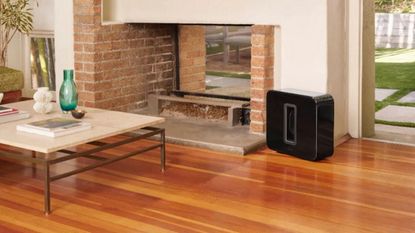Where to place a subwoofer in relation to your soundbar - say goodbye to lackluster home audio
Wondering where to put that boxy speaker that came with your soundbar? We have the answers


If you're keen to set up the ultimate audio system (and who isn't?), then getting the details right can be the difference between shallow, disappointing sound and super-charging your music, movies, and more. All but the nerdiest of audiophiles often misunderstand subwoofers, but they play an essential role in making home theater systems the best they can be.
Placement is one of the first questions people seem to have about subwoofers, and it can be tricky to find the perfect spot for such a bulky device. In this article, we review the key factors that can impact a subwoofer's performance and where best to place it in relation to a soundbar or other speaker set-up. For more, take a look at our guide to the best subwoofers chosen by our experts.

How do subwoofers work?
For those outside the home theater world, it may be challenging to understand the intricacies of subwoofers and what they bring to an audio system. Subwoofers deliver low-frequency sounds that can enhance and deepen the listening experience. These sounds add an element of booming bass that might be lacking without a subwoofer.
To deliver this type of sound, a subwoofer utilizes a diaphragm that moves back and forth rapidly when it receives a signal from an amplifier. The resulting air pressure fluctuations create sound waves responsible for producing the low-frequency sounds that subwoofers are known for. Subwoofers also typically come equipped with cabinets to ensure the air pressure is appropriately controlled, resulting in a higher-quality sound.

How close to a soundbar should your subwoofer be?
The answer to how far a subwoofer should be placed away from a soundbar largely depends on your setup. For example, a wired subwoofer can only stretch so far, whereas a wireless speaker gives you more freedom.
For both kinds, you should always leave around 6-12 inches around your sub for best audio results, as sound waves need space to move around. Wireless subwoofers will most likely have a maximum connectivity range that will dictate the area you have to play with, but closer often yields better results. Somewhere in the region of 10ft should ensure a rich sound.
This also applies to the best surround sound systems, which often incorporate subwoofers to produce the best audio impact.
Which way should your subwoofer be facing?
The natural place most people go for when positioning their subwoofer is at the front of the room beside the soundbar, which is a solid choice. However, when placed to the left or right of the soundbar or other speaker set-up, the subwoofer should face out towards the rest of the room.
Some also claim that placing a subwoofer in the corner of a room (close to walls) can improve audio even more because of sound reflections, but this is debated.

Should your subwoofer be on the floor?
The natural place for a subwoofer in your standard living area is on the floor, but alternative options exist. One school of thought indicates that elevating your subwoofer will increase sound quality, but others say placing it on the floor adds a greater controlled output.
There are also two types of subwoofers - forward-firing and downward-firing - with the latter designed to channel bass waves through the floor. Still, with a downward-firing subwoofer, it's recommended that you place it on the floor but facing forwards.
If you have carpet, this is beneficial, as subwoofers sound better on carpets than they do on hard floors. This is because the softness of the surface absorbs sound waves and cushions the speaker to prevent rattling that could interfere with the output.

Do all soundbars need subwoofers?
Soundbars don't necessarily need subwoofers to create a deep sound, but it helps. That said, many high-end soundbars come with their own built-in subwoofers, so they don't require a separate component.
Outside of this, whether you need to incorporate a dedicated subwoofer into your sound system depends on your preference. For example, if you listen to a lot of music or watch many action movies, added bass will significantly benefit your overall listening experience. This is also true if you have a large space and might need more oomph to get the full impact.
Where should you place a subwoofer in relation to your soundbar?
Subwoofer placement depends on the system's setup, but leaving some space between the soundbar and the subwoofer and facing it in the direction of the room can help improve sound quality. A carpeted floor or elevating the subwoofer can also affect the sound quality. It is true that the best soundbars can deliver deep sound without using a subwoofer. Still, their inclusion in large spaces can greatly enhance the listening experience when listening to music or watching action movies, as it enhances the depth of the sound.
Be The First To Know
The Livingetc newsletter is your shortcut to the now and the next in home design. Subscribe today to receive a stunning free 200-page book of the best homes from around the world.

Caroline is the smart home ecommerce editor for Livingetc, covering everything tech for the home, from smart speakers to air purifiers and everything in between. She is passionate about the role that technology and smart devices can play in daily life, enhancing the home without sacrificing personal style and carefully chosen interiors. In her spare time, she can be found tinkering with bulbs, soundbars, and video doorbells in an effort to automate every part of her small home. Previously, she lent her expertise to the likes of Expert Reviews, IT Pro, Coach, The Week, and more.
-
 How to Thaw a Frozen Pipe — Learn Everything You Need to Know in 5 Minutes With This Guide
How to Thaw a Frozen Pipe — Learn Everything You Need to Know in 5 Minutes With This GuideWinter storm caught you off guard? We asked an expert — just how do you thaw a frozen pipe?
By Hugh Metcalf Published
-
 The 12 Very Best Silk Bedding Pieces — As Our Style Editor Says: 'It's What Dreams Are Made Of!'
The 12 Very Best Silk Bedding Pieces — As Our Style Editor Says: 'It's What Dreams Are Made Of!'Slumber in lustrous luxury with the very best silk bedding sheets, duvets, pillowcases, and more — your sleep score will thank us later
By Julia Demer Published

